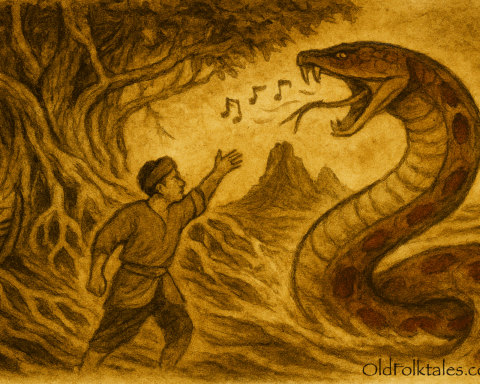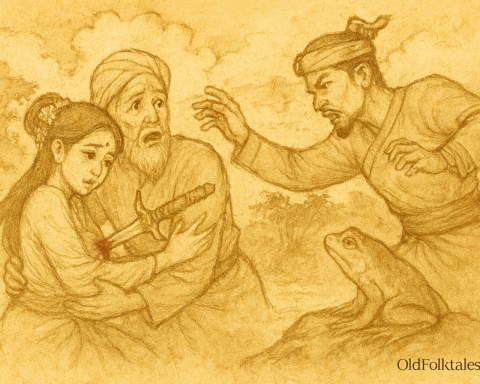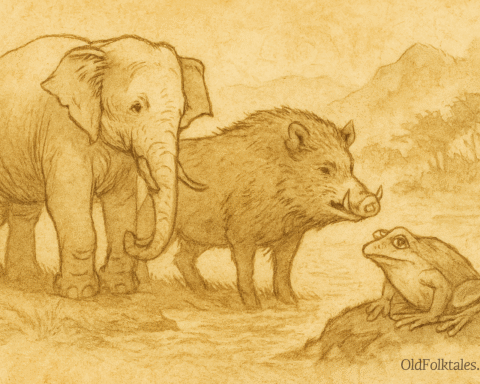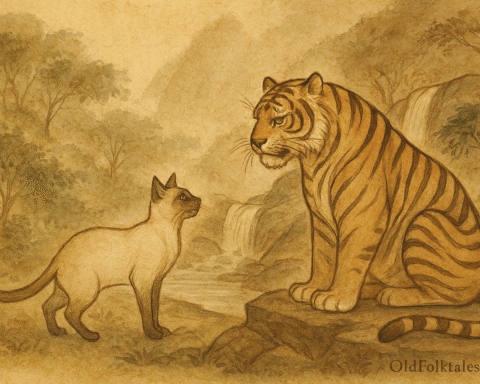There was once a little girl who lived in a village where every tradition carried deep meaning. Among the most important customs was the tattooing of the lips, a rite of passage marking the journey from childhood into maturity. When the day came for her age group to be tattooed, the girl was eager to join her companions. But to her shock and sorrow, she was told she could not be tattooed. For her, it was taboo.
Her heart grew heavy. As her friends prepared for the ritual, she wept bitterly. Tears streamed down her cheeks as she wandered into the quiet bush, her sobs echoing through the trees. She felt isolated, different, and excluded from the bond her companions now shared.
While she sat crying, a spirit appeared. The spirit transformed itself into a little old woman and approached her gently.
“Child,” the old woman asked, “what troubles you so deeply that you cry alone in the wilderness?”
The girl, overcome with grief, replied, “No one can take this sadness from me.”
“Tell me,” the old woman pressed kindly, “what has caused your sorrow?”
The girl confessed through tears: “All my age mates went for tattooing, but for me, it is forbidden.”
The old woman chuckled softly. “Is that all? If this is the cause of your grief, I can help you. I will tattoo you. But listen carefully: until this same day returns in the next year, you must not tell anyone. If you reveal what I have done, the price will be death.”
The girl quickly agreed.
READ THIS: The River Crossing and the Hippopotamus
The old woman then began her work. She tattooed the girl’s lips until they were deeply black, polished her teeth until they shone white as pearls, then sucked her in and spat her out. In an instant, the girl’s appearance was transformed, she had become very beautiful. The spirit warned her again, “Remember, child. Keep silent. Do not reveal this secret until the day of tattooing comes again.”
The girl returned home, silent and thoughtful. Her mother noticed immediately.
“My daughter,” she asked, “what has happened to you?”
The girl said nothing.
Her companions questioned her as well, but still, she remained silent. Days passed, and her mother grew anxious. Finally, the mother devised a test with the hawk. The plan was simple: when the girls went to the pool to bathe, the hawk would seize their clothes and only return them after each girl sang a song to claim her garments.
When the girls gathered at the pool, the hawk swooped down, snatched their clothing, and perched in a tall tree. One by one, each girl sang, and the hawk returned her clothes. Laughter filled the air until only the silent girl remained, shivering without her garments.
At last, under pressure, she sang, but she kept her lips tightly closed. The hawk, displeased, refused to return her clothes. Her companions urged her to open her mouth and sing again. Finally, cornered, she smiled. At that moment, everyone gasped in amazement. Her lips were inked black, and her teeth gleamed with unnatural brightness. Now they understood why she had guarded her silence so fiercely. The hawk, satisfied, returned her clothes.
Back at home, the girl gathered her age group and began to sing for her mother. With each song, her mother gave her gifts: millet, cooking pots, and food. The girl sang again, dismissing her companions and announcing she was “going home.”
With that, she lay down quietly. Her body stilled, and she died. Her family and companions buried her, and on her grave, a small cotton tree sprouted. It grew into a beautiful little tree, admired by all who passed. Villagers would stop and say, “Look at this cotton tree, it is as beautiful as the girl herself.”
Moral of the Story
The folktale of Lip Tattooing reminds us of the weight of secrecy and the danger of breaking promises. It also reflects the cultural significance of beauty, tradition, and silence, showing how pride and hidden truths can lead to sorrowful consequences.
Knowledge Check
Q1: Who told the girl she could not be tattooed?
Her family and community declared tattooing taboo for her.
Q2: What form did the spirit take when it appeared to the girl?
The spirit changed into the form of a little old woman.
Q3: What transformation did the old woman give the girl?
She tattooed her lips black, polished her teeth, and made her very beautiful.
Q4: Why did the girl refuse to speak after returning home?
Because she was bound by the spirit’s warning: if she revealed the secret, she would die.
Q5: What test did the hawk use to reveal her secret?
It seized the girls’ clothes at the pool and returned them only when each sang.
Q6: What grew on the girl’s grave after her death?
A beautiful little cotton tree, admired by all who saw it.
Source: Ethiopian folktale






